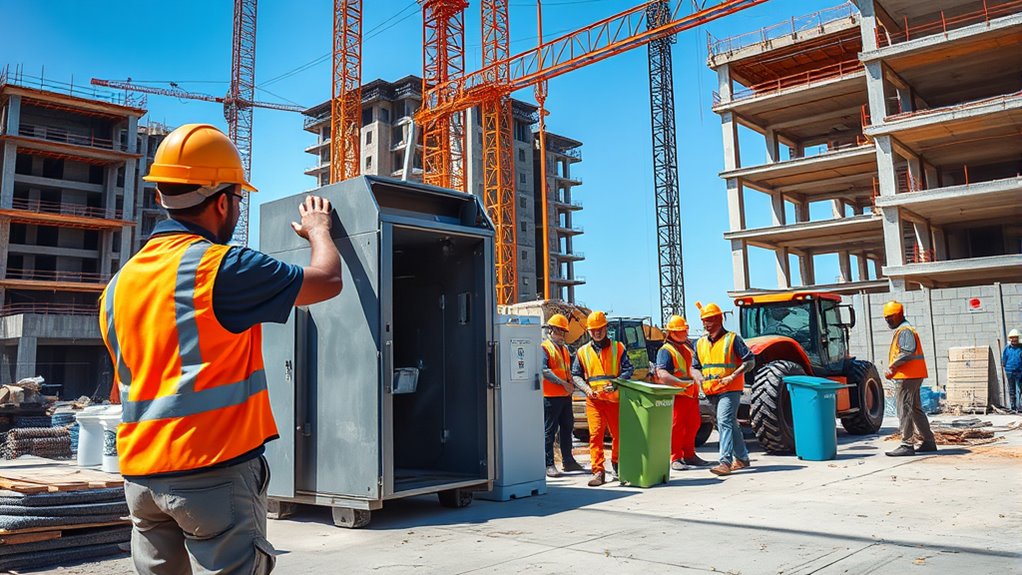As someone on the construction crew, you know how crucial reliable sanitation features are for safety and efficiency. You rely on strategically placed handwashing stations with soap and sanitizer, always within reach to keep germs at bay. Portable toilets must be clean and accessible, while waste disposal bins help prevent clutter. Proper tool maintenance reduces accidents, all supported by a culture of hygiene. Keep exploring to discover more essential sanitation features that keep you safe and productive every day.
Key Takeaways
- Accessible handwashing stations equipped with soap, water, and sanitizer to promote daily hygiene.
- Well-maintained portable toilets for sanitary and comfortable facilities on-site.
- Regularly emptied waste disposal bins to prevent clutter and health hazards.
- Proper tool and equipment maintenance to ensure safety and reduce malfunctions.
- A safety-oriented culture emphasizing hygiene to prevent illness and promote responsibility.

Construction crews often have valuable insights that can improve project efficiency and safety, yet their voices are frequently overlooked. When it comes to sanitation features on a job site, their perspectives are essential. Clean, well-maintained facilities aren’t just about comfort—they directly impact safety and productivity. If sanitation isn’t prioritized, it can lead to health issues, decreased morale, and even accidents. As someone on the ground, you know that a well-thought-out sanitation setup can make a significant difference.
First and foremost, accessible handwashing stations are non-negotiable. You need to be able to wash your hands quickly and effectively, especially after handling materials or using tools. These stations should be strategically placed around the site, near high-traffic areas, and equipped with soap, water, and hand sanitizer. Proper sanitation helps reduce the spread of germs and keeps everyone healthier, which means fewer sick days and smoother workflows. You might notice that when these stations are conveniently located, workers are more likely to wash their hands regularly, reinforcing the importance of good hygiene practices.
Alongside handwashing stations, portable toilets are essential sanitation features that demand attention. They must be regularly cleaned and maintained to prevent odors, overflows, and other health hazards. It’s frustrating when these facilities are neglected, leading to unsanitary conditions that can compromise safety and morale. You know from experience that comfortable, clean toilets encourage proper use and reduce the temptation to find alternative, less hygienic options. When tool maintenance is also prioritized, it reduces the risk of accidents caused by malfunctioning equipment. Well-maintained tools are safer to operate and less likely to cause injuries, which ties directly into the overall safety protocols on site.
Another feature you value is proper waste disposal. Having designated trash and recycling bins that are emptied regularly prevents clutter and potential hazards. It’s about creating an environment where safety isn’t compromised by debris or waste piling up. Good sanitation isn’t just about comfort; it’s an essential part of maintaining a safe, efficient work environment. You might also consider the importance of proper hygiene practices in preventing the spread of illness among workers. When everyone understands that sanitation and tool maintenance are priorities, it fosters a culture of safety and responsibility. You’d likely agree that these features aren’t just amenities—they’re fundamental components of a well-run construction site, reinforcing safety protocols and ensuring everyone can work without unnecessary risks. Your voice matters in advocating for these features, because ultimately, they protect you and your colleagues every single day.
Frequently Asked Questions
How Do Sanitation Features Impact Construction Project Timelines?
Sanitation features directly impact your construction project timelines by ensuring smooth waste management and quick access to portable units. When you have reliable portable units on-site, waste clears faster, preventing delays caused by clutter or health hazards. Efficient sanitation reduces downtime, keeps workers healthy and productive, and minimizes disruptions. Overall, good sanitation features streamline your workflow, helping you stay on schedule and avoid costly project delays.
What Safety Considerations Are Linked to Sanitation Features?
You need to prioritize safety considerations linked to sanitation features by focusing on hazard prevention and compliance standards. Guarantee proper waste disposal to prevent slips, trips, and exposure to harmful substances. Regular maintenance reduces health risks, while adhering to standards like OSHA guidelines keeps everyone protected. By implementing these measures, you create a safer work environment that minimizes accidents and promotes overall safety on your construction site.
Are There Eco-Friendly Sanitation Options Available?
Think of eco-friendly sanitation options as a invigorating gust of fresh air in construction sites. You’ll find sustainable solutions like composting toilets, waterless urinals, and biodegradable waste bags that reduce environmental impact. These eco-friendly alternatives help conserve resources and promote greener practices. Incorporating sustainable solutions not only benefits the planet but also boosts your company’s reputation, making your site a model of responsible construction.
How Do Sanitation Features Vary for Different Construction Site Types?
You’ll find that sanitation features differ based on construction site types. For smaller projects, portable toilets and basic handwashing stations might suffice, while larger sites require multiple units and specialized facilities like accessible or eco-friendly options. Your goal is to guarantee workers have reliable access to clean portable toilets and handwashing stations, which helps maintain hygiene, safety, and compliance no matter the site size or scope.
What Is the Maintenance Requirement for Advanced Sanitation Systems?
Imagine you’re managing a futuristic waste disposal system that’s as tough as a tank. You’ll need to regularly inspect and clean advanced sanitation systems to guarantee system durability and prevent malfunctions. Maintenance involves checking sensors, replacing filters, and ensuring proper waste disposal. Staying on top of these tasks keeps the system running smoothly, reduces downtime, and extends its lifespan, making sure sanitation features remain reliable in even the busiest construction sites.
Conclusion
As you work tirelessly on every project, remember that these sanitation features aren’t just conveniences—they’re the foundation of a safe, efficient job site. Without them, the chaos of construction would drown out progress like a storm drowning out the calm. Keep these essentials close; they’re the unseen heroes supporting your hard work. After all, in the symphony of construction, proper sanitation isn’t just a note—it’s the melody that keeps everything in harmony.









